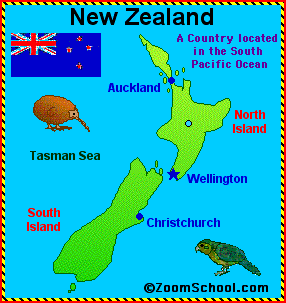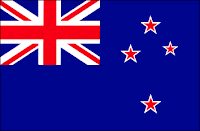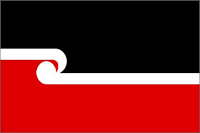New Zealand
popularité : 43%
L’idéal, pour la première séance, est de disposer d’un laboratoire de langue, afin que les élèves puissent chacun écouter le texte à leur rythme, varier sa vitesse etc...
Therefore, if you go to this wonderful and wild country, always remember :
– You ……………………swim far from the shores : there are many species of dangerous sharks and jellyfishes. Both ……………….. kill you if you come too close from them.
– You ………………….be afraid of ……………….. or ………………. if you come. As a matter of fact, they are really numerous in New Zealand ! Common reptiles include skinks, geckos and tuatara, and weta is the most famous of all insects here : it is the heaviest in the world as it …………………..grow as large as a …………………..!!! Besides, don’t worry, there are no …………………… on the islands…
– Some years ago, you …………………….. see many incredible ……………. here. But some are extinguished now, such as the Moa or the Haast’s eagle, and many others are endangered due to human actions, such as the kiwi, kakapo and takahe…
– You …………………… also admire our amazing nature. Check out the silver fern, one of our national emblem ! Or the Pōhutukawa, also called "New Zealand Christmas ……………….." because of its vivid red color. But try not to pick up …………………., many are protected.
To conclude, remember you …………………. take home as many pictures as you want !!! Show them to your friends, New Zealand’s wildlife is so extraordinary they ……………………. wish to come and visit too."
![]()
DO’S & DON’TS IN NEW ZEALAND
"Because of its isolation from the rest of the world, New Zealand, also known as Aotearoa in Maori (the land of the long white cloud), has extraordinary flora and fauna you must learn to respect and protect.
Therefore, if you go to this wonderful and wild country, always remember :
– You shouldn’t swim far from the shores : there are many species of dangerous sharks and jellyfishes. Both may kill you if you come too close from them.
 - You mustn’t be afraid of reptiles or insects if you come. As a matter of fact, they are really numerous in New Zealand ! Common reptiles include skinks, geckos and tuataras, and weta is the most famous of all insects here : it is the heaviest in the world as it can grow as large as a mouse !!! Besides, don’t worry, there are no snakes on the islands…
- You mustn’t be afraid of reptiles or insects if you come. As a matter of fact, they are really numerous in New Zealand ! Common reptiles include skinks, geckos and tuataras, and weta is the most famous of all insects here : it is the heaviest in the world as it can grow as large as a mouse !!! Besides, don’t worry, there are no snakes on the islands…
 - Some years ago, you could see many incredible birds here. But some are extinguished now, such as the Moa or the Haast’s eagle, and many others are endangered due to human actions, such as the kiwi, kakapo and takahe…
- Some years ago, you could see many incredible birds here. But some are extinguished now, such as the Moa or the Haast’s eagle, and many others are endangered due to human actions, such as the kiwi, kakapo and takahe…
To conclude, remember you can take home as many pictures as you want !!! Show them to your friends, New Zealand’s wildlife is so extraordinary they might wish to come and visit too."
(les noms en gras sont les animaux représentés par les gifs)
.
.
II- COMPREHENSION DU TEXTE
1- Right or wrong ? Justify.
New Zealand’s wildlife is extremely poor
……………………………………………………………
Some jellyfishes can be lethal
……………………………………………………………
The wetas are the smallest insects on the islands
……………………………………………………………
New Zealand has always been a real sanctuary for birds
……………………………………………………………
Pōhutukawa is New Zealand’s national tree
…………………………………………………………
.
2- Questions on the text
a- What’s the Maori name for New Zealand ? What does it mean ?
b- Are there many reptiles and insects in New Zealand ?
c- Should you be scared of snakes in New Zealand ?
d- Does the Moa still live on the islands ?
e- What’s New Zealand’s national emblem when it comes to flora ?
.
3- What do you think ?
a- What do you think about New Zealand’s special wildlife ?
b- What are your favorite New Zealand animals ? Why ?
c- Would you like to visit New Zealand ? Why ?
d- Would you like to live in New Zealand ? Why ?
.
III- GRAMMAIRE
.
Les modaux, en particulier.
.
IV- CIVILISATION
1- La carte du pays

2- Les drapeaux
.
a- le drapeau officiel
 Le drapeau néo-zélandais regroupe deux éléments : l’Union-Jack et la Croix du Sud.
Le drapeau néo-zélandais regroupe deux éléments : l’Union-Jack et la Croix du Sud.
L’Union-Jack, drapeau du Royaume-Uni, traduit l’appartenance de la Nouvelle-Zélande au Commonwealth.
Les quatre étoiles rouges symbolisent les quatre étoiles les plus brillantes de la Croix du Sud, constellation de l’hémisphère austral, servant autrefois aux navigateurs de repère d’orientation.
.
.
b- Le drapeau des Maoris :
 Ce drapeau maori a été conçu en 1990. Le noir représente l’obscurité d’où le monde a émergé ; le blanc représente le monde physique, la pureté, l’harmonie ; le rouge représente la couleur de la terre où le premier humain à été crée.
Ce drapeau maori a été conçu en 1990. Le noir représente l’obscurité d’où le monde a émergé ; le blanc représente le monde physique, la pureté, l’harmonie ; le rouge représente la couleur de la terre où le premier humain à été crée.
Le symbole central (« Koru ») représente la nouvelle vie, le renouvellement, l’espoir.
.
.
– "God save the Queen_" (l’hymne britannique) ;
e- Les Maoris
Quelques mots maoris : - Tena koe : bonjour
– Kia ora = Merci (= que tu vives !)



